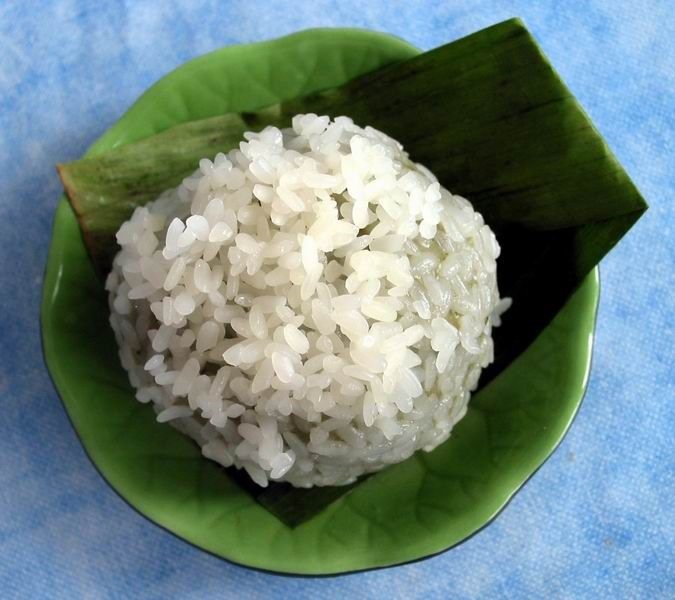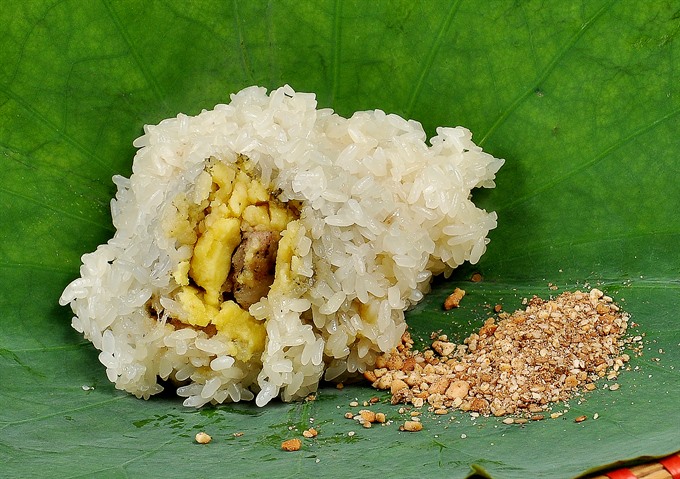 Life & Style
Life & Style

" />Hà Nội’s winter is said to be incomplete without savouring bánh khúc or xôi khúc.
 |
| Sticky treat: Bánh khúc is a popular dish in Hà Nội during winter. — Photo mytour.vn |
By Phương Hà
Hà Nội’s winter is said to be incomplete without savouring bánh khúc or xôi khúc.
The dish is a ball of glutinous rice mixed with cudweed and filled with mung bean paste and seasoned greasy pork. It is best tasted when served steaming hot, which is why it is a must-have dish during the cold winter months.
Another reason why the dish is popular during winter is because the most important ingredient - cudweed - grows abundantly during late winter. In the first two months of the year, when an early spring drizzle envelops the villages and farms, cudweed is also harvested.
The plant grows naturally along river banks and on the edges of fields.
There are two kinds of cudweed - tẻ (non-sticky) and nếp (sticky). Of these, tẻ is preferred to make bánh khúc as it is more flexible and fragrant.
On cold winter nights in Hà Nội, street vendors are often heard shouting, “Ai bánh khúc đây?” (Who wants bánh khúc?) on nearly every street. This is a familiar call for anyone who has lived in the capital for a long time. However, there are only two popular places serving the most authentic and delicious bánh khúc in the city: Bánh Khúc Quân and Bánh Khúc Cô Lan.
Bánh Khúc Quân
“I have tried bánh khúc in many places, but nowhere have I found as soft and sweet-smelling layer of steamed glutinous rice as sold in Bánh Khúc Quân shop,” says Bùi Tuyết Loan, a resident on Hàng Bông Street.
Shop owner Nguyễn Văn Quân revealed that the secret to their dish, beside the right cudweed, was the Nhung glutinous rice that was grown in Việt Nam’s northern provinces. The special rice, with its big grains, keeps the dish sticky even when it has cooled down. The grains do not harden even when they are refrigerated or heated in a microwave.
“The rice is then soaked in water according to a technique devised by my family, like at a particular temperature and for a particular duration. If the rice is soaked for too long, it can get crushed, and if it is not soaked enough, it might become too hard,” Quân said.
To make the dish, the cudweed is well brayed to obtain the mash liquor, which is then mixed with the glutinous powder. This is then kneaded well to create the covering layer. The filling of the dish is made with well-kneaded ground mung beans, which wraps the well-seasoned lean and fat pork.
The final product is steamed in a clay pot to ensure its taste and temperature.
Each portion is wrapped in a banana leaf before being handed over to customers. A pack of sesame and salt is given complimentary. One portion costs VNĐ13,000 (60 US cents).
 |
| Winter warmer: Bánh khúc is a ball of glutinous rice mixed with cudweed and filled with mung bean paste and well-seasoned greasy pork. — Photo banhkhucolan.com |
Bánh Khúc cô Lan
Small shops located along the streets of Hà Nội have hanging signboards that read Bánh khúc cô Lan, another popular brand name of bánh khúc in the city.
The recipe of bánh khúc cô Lan might be similar to that served in Bánh Khúc Quân, but each shop has a different method of choosing the ingredients.
According to Nguyễn Thị Lan, owner of the brand name Bánh khúc cô Lan, the glutinous rice and mung beans are thoroughly selected, and the filling of the rice ball contains a lot of well-kneaded ground mung bean mixed with cudweed.
“The technique of cooking the mung bean is crucial,” she says. “If the mung bean is too crushed, the whole dish will become crushed and if the mung bean is hard, the whole rice ball will become friable.”
Customers who prefer a greasy taste might find their favourite bánh khúc in Lan’s shop, as the fillings there contain more greasy lean and fat pork, wrapped in layers of steamed glutinous rice, mung beans and brayed cudweed. Each portion costs VNĐ13,000, the same as Bánh Khúc Quân.
Though the cudweed grows only during winter, it can be collected and dried and stored for use in bánh khúc throughout the year. But it’s only in winter that the dish tastes the best, for its ingredients have been freshly harvested.
“A serving of bánh khúc seems to be small, but it’s actually filling. The colours and flavours of its ingredients mix well to create its unique taste,” says Lan. — VNS
In box:
Bánh Khúc Quân branches are located in the following addresses:
- 35 Cầu Gỗ Street, Hoàn Kiếm District.
- 102, C6, Lương Định Của Street, Đống Đa District.
- Lane 46B, Phạm Ngọc Thạch Street, Đống Đa District.
Bánh Khúc Cô Lan branches are as follows:
- 69B Nguyễn Công Trứ Street, Hai Bà Trưng District.
- 20 Lê Duẩn Street, Hoàn Kiếm District.
- 29 Nguyễn Thái Học Street, Ba Đình District.
- 255 Thụy Khuê Street, Tây Hồ District.
- 443 Minh Khai Street, Hai Bà Trưng Dist.




